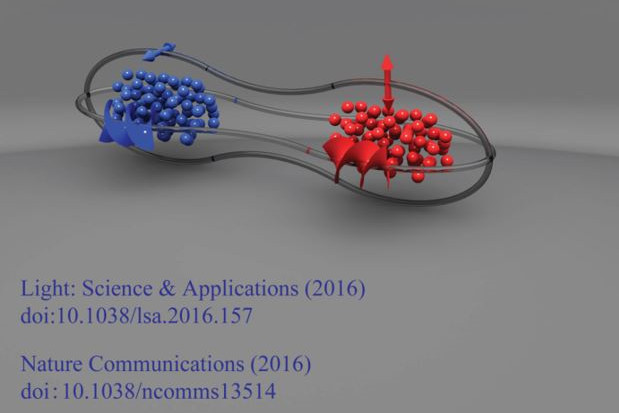USTC realized the entanglement in multiple degrees of freedom between two quantum memories
The cold atomic physics research group of Key Laboratory of Quantum Information, CAS, led by academician GUO Guangcan, has achieved a series of significant progresses in quantum storage: Prof. SHI Baosen, Prof. Ding Dongsheng and their collaborators established a high-dimensional entanglement and a 2´3 hyper-entanglement between two separated quantum memories. The main results have been published in journals “Light: Science & Applications” (Light: Sci. & Appl. 5, e16157 (2016)) and “Nature Communications” (Nat. Commun. 7, 13514 (2016)) respectively Entangled quantum states in high-dimensional space for example consisted of orbital angular momentum show many advantages compared with entangled states in two-dimensional space. The former enables quantum communication with higher channel capacity and more efficient quantum-information processing, and is more feasible for closing the detection loophole in Bell test experiments, etc. Long-distance quantum communication requires the distribution of quantum entanglement among different nodes. To overcome the exponential scaling of the error rate with the channel length, the concept of quantum repeater is introduced, which combines entanglement swapping and quantum memory to efficiently extend the achievable distance of quantum communication. So establishing high-dimensional entangled memories is a critical step towards a high-capacity quantum network.
The group of Prof. Shi baosen has focused on the research about the quantum storage of high dimensional quantum states over several years, achieved several important progresses during the past years, for example, they have realized the first quantum memory of single photon carrying OAM (Nat. Commun. 4, 2527(2013)) and realized the quantum storage of a two-dimensional OAM entanglement for the first time (Phys. Rev. Lett. 114, 050502 (2015)). Recently, they made another big step along this direction: experimentally realized a high-dimensional entanglement between the spin-excited states of two cold atomic ensembles. The experimental results showed that two quantum memories were entangled up to seven dimensions. The main results are published in the journal of Light: Science & Applications [Light: Sci. & Appl. 5, e16157 (2016)].
Acting as information carriers, photons can be entangled in single degree of freedom (DOF), such as polarization, or entangled in multiple DOFs independently as hyperentanglement or entangled in multiple DOFs mutually as hybrid entanglement. Entanglement in multiple DOFs shows more advantages than the entanglement in single DOF, for example, multiple-DOFs hyperentanglement enables high efficiency for Bell measurement, and it even makes super dense coding breaking the conventional linear-optics threshold achievable. Meanwhile, entanglement in multiple DOFs can be utilized in the scenario of asymmetric optical quantum network and generation of multi-qubit entangled states. Furthermore, hyperentanglement has many applications in improving the techniques for state purification, obtaining the quantum computing, and tests for the nonlocality. There are some important progresses achieved recently, such as the preparation of hyperentanglement states, quantum teleportation based on hyperentanglement, however, memory-memory entanglement in multiple DOFs has not yet been reported, which represents a critical step towards multi-DOFs quantum repeater.
The group led by Prof. Shi experimentally established hyper- and hybrid entanglement in multiple degrees of freedom, including path (K-vector) and OAM between two separated atomic ensembles by using quantum storage. The results are promising for achieving quantum communication and computing with many degrees of freedom. The main results are published in the journal of Nat. Commun. 7, 13514 (2016).

This figure shows the multiple DOFs entanglement between two separated atomic ensembles
This work is supported by the National Natural Science Foundation of China, the National Fundamental Research Program of China.
Article links:
http://www.nature.com/lsa/journal/v5/n10/full/lsa2016157a.html
http://www.nature.com/articles/ncomms13514
(DUAN Kaimin,School of Physics Science)
未命名.jpg
Back
